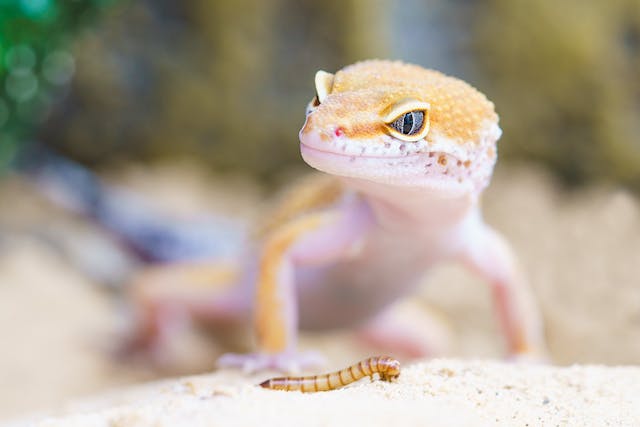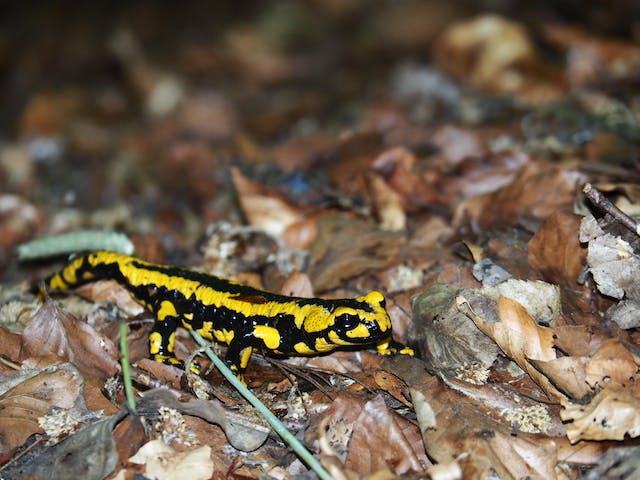Geckos and salamanders may appear similar to you but they belong to different classes. Salamanders are amphibians just like frogs, while geckos are reptiles often seen crawling up the walls in a house.
Salamanders and geckos both resemble lizards with their colourful patterns. Geckos prefer to stay in warmer climates, while some salamander species are fully aquatic throughout their lives.
Geckos vs salamanders are two different animals that look alike. Geckos can grow up to 3 to 15 cm in length, while the largest salamander can grow up to 1.8 metres to 2 metres.
For someone who cannot differentiate between a gecko and a salamander, here is an article that discusses the differences between these two lizard-like creatures.

What are Geckos?
Geckos are small nocturnal and mostly carnivore lizards found in every continent, except Antarctica. Naturally, geckos prefer to live in warmer climates and they are often found crawling up walls in homes.
These nocturnal reptiles have a short stout body, well-developed limbs and a large head. Most species of geckos can grow up to 3 to 15 (1.2 to 6 inches) in length.
Geckos are reptiles with a soft skin. They are unique among lizards and are known for their vocalizations, which are naturally different from species to species.
Geckos in the family Gekkonidae use clicking or chirping sounds to engage in social interactions.
Tokay geckos are only native to Asia and some Pacific Islands. These nocturnal arboreal geckos are known to make loud mating calls. Other species of geckos make hissing noises when threatened or alarmed in their natural habitat.
As we said earlier, geckos live on all continents across the world except Antarctica. There are over 1,850 different species of geckos inhabiting their preferred warmer climate.
All species of geckos, except those in the family Eublepharide naturally do not have eyelids. Most species of geckos only have the brill, a transparent membrane covering the outer surface of the eyeballs.
Geckos possess a fixed lens within each iris, which enables them to see better in the dark. This is why geckos are usually found in homes where they crawl up walls searching for insects to feed on.
These nocturnal reptiles naturally cannot blink as most species are without eyelids. They only rely on licking their brills when they need to clear dust or dirt from them.
Also Read: Buck vs Stag: Difference and Comparison
What are Salamanders?
Salamanders are amphibians that naturally resemble lizards, with blunt snouts, slender bodies, and short limbs. Salamanders naturally appear in a variety of mixed and spotted colours.
These colourful amphibians are only found in the Holarctic and Neotropical regions. However, most species of salamanders are mainly found in eastern Northern America, mostly in the Appalachian Mountains.
This group of amphibians rarely possesses more than four toes on their front legs and five on their rear legs. However, there are other species with fewer digits, while other species naturally lack limbs.
Salamanders are amphibians with slender bodies. Their permeable skin makes them rely on flourishing in natural habitats near water or in cool or damp places.
Salamanders are known to grow up to 10 to 15 cm (4 to 6 inches) in length. Some salamander species can grow up to 1.8 metres to 2 metres in length. Many species of these amphibians are camouflaged, while others are badly patterned or brightly coloured.
The Chinese giant salamander and the Japanese giant salamander can grow up to 6.6 feet (2 meters) and 5.6 feet (1.7 metres) in length.

Also Read: Squid vs Octopus: Difference and Comparison
Geckos vs Salamanders: Key Differences between Geckos and Salamanders
Geckos and salamanders are two lizard-like creatures that belong to a different family. Geckos are reptiles mainly found in warmer climates, while salamanders are amphibians only found in the Holarctic and Neotropical regions.
Geckos vs salamanders share a similar body shape and colour patterns. But this is the only similarity between these two lizard-like creatures.
One of the differences between geckos and salamanders is in their reproduction. Naturally, amphibians and reptiles lay eggs that hatch within a short period.
Geckos lay shelled amniotic eggs, while salamanders lay eggs with no shell.
Let’s look at more differences between geckos and salamanders.
Geckos vs Salamanders: Natural Habitat
The natural habitat of geckos and salamanders highlights a common difference between them.
Salamanders are a group of amphibians that naturally love to live in moist or damp areas. This usually includes temperate forests, creeks, and brooks.
This is their preferred natural habitat that helps these amphibians to easily move around. Some salamanders prefer not to leave their aquatic habitat, settling there permanently.
Salamanders flourish in aquatic habitats, while geckos thrive in warmer climates.
Geckos live in deserts, mountainous terrain and on trees in rainforests. They also find their way into our homes, where they hunt for insects when it’s dark.
Unlike geckos, salamanders cannot survive in the desert or any other warmer habitat. Their slender bodies can only survive in aquatic habitats, as exposure to warm and dry weather may cause death.
Also Read: King Crab vs Dungeness Crab: Difference and Comparison
Geckos vs Salamanders: Size
When comparing sizes, geckos and salamanders are about the same size, but it all depends on the species.
On average, geckos can grow up to 3 to 15 (1.2 to 6 inches) in length. The smallest geckos however only measure about 0.6 inches. The largest species of gecko, which is the New Caledonian giant and the world’s largest gecko can grow up to 14 to 17 inches in length and weigh about 10 ounces.
The smallest salamander is about 0.6 inches in length, while the largest can grow up to 2 meters.
The two largest species are the Chinese giant salamander and the Japanese giant salamander me6.6 feet (2 meters) and 5.6 feet (1.7 metres) in length.
Geckos vs Salamanders: Skin
Another noticeable difference between salamanders and geckos is their skin. Salamanders are amphibians with moist and slimy skin, while geckos have thicker, rough, and warty skin.
Salamanders need to live in areas where their skin will remain moist. They produce a mucus-like substance from their body, which helps them to navigate their habitat.
The mucus-like substance also enables the bodily function of these amphibians- such as their heartbeats and breathing.
Geckos vs Salamanders: Diet
Geckos and salamanders feed on insects and other plant materials in their habitat. Salamanders roam their habitat to search for insects such as spiders, flies, and sometimes worms.
Geckos found in homes also feed on small insects like flies, spiders, and tiny roaches.
Also Read: Canine vs Feline: Difference and Comparison
Geckos vs Salamanders: Comparison Chart
| Geckos | Salamanders | |
| Classification | Reptiles | Amphibians |
| Distinctive features | Sticky toe pads for climbing | Ability to regenerate limbs |
| Size | Ranges from 5 to 24 inches in length depending on the species | Averages from 4 to 8 inches in length and most species can reach 6 inches and even 6 feet |
| Habitat | Rainforests, deserts, and mountains | Their natural habitat is in water or near water, moist grounds, like creeks, under rocks, and ponds |
| Egg type | Hard-shelled eggs | Soft, jelly-like eggs laid in water |
| Skin | Smooth but warty or rough | Moist and smooth, sometimes very permeable to water. |
| Activity time | Mostly nocturnal | Varies, some species are nocturnal and others are diurnal |
Conclusion
Geckos and salamanders are two lizard-like creatures that belong to a different family. Salamanders are amphibians that mostly live near aquatic habitats, while geckos are reptiles naturally found in warmer climates.
Geckos and salamanders differ in size depending on the species, and there is a noticeable difference in their skin texture.
Recommendations
- Doe vs Buck: Difference and Comparison
- Slug vs Snail: Difference and Comparison
- Cockroach vs Beetle: Difference and Comparison
- Lice vs Tick: Difference and Comparison
- Groundhog vs Beaver: Difference and Comparison
References
- Wikipedia: Gecko
- Britannica.com: salamander
- A-Zanimals: Salamander vs Gecko: What are the Differences?

Leave a Reply